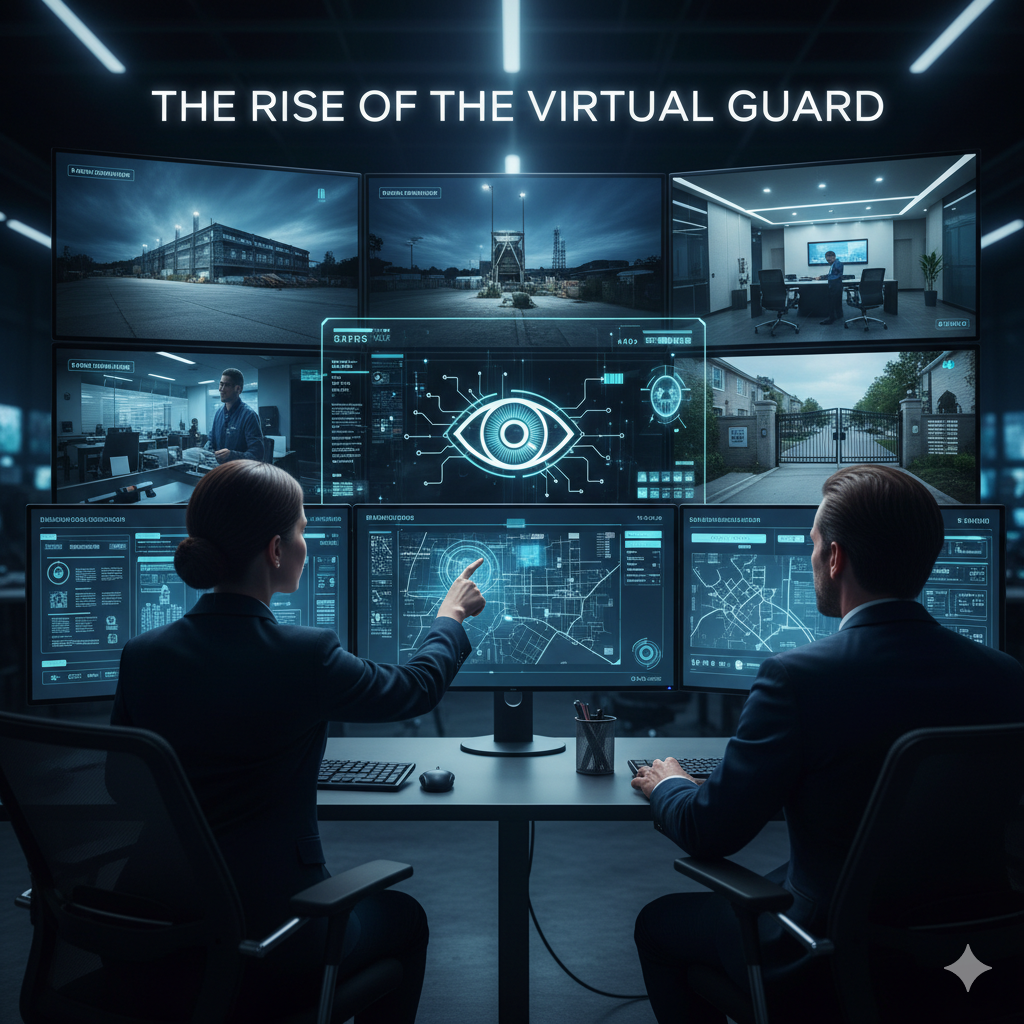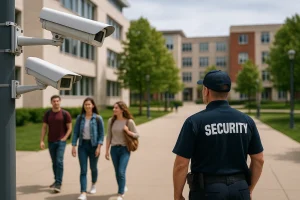The Rise of the Virtual Guard: A Modern Solution for a Changing World
Explore the growing trend of virtual guarding. Discover the benefits, challenges, and ideal applications of remote security for modern businesses, enhancing efficiency and saving costs.
By Chrissy
September 1, 2025

The Rise of the Virtual Guard: A Modern Solution for a Changing World
The security landscape is evolving, and with it, the role of the security guard. As technology becomes more integrated into every aspect of our lives, a new concept is gaining significant traction: the virtual guard. This innovative approach uses advanced technology to provide security from a remote location, offering a compelling alternative or supplement to traditional on-site personnel. This article explores the growing popularity of remote guarding, detailing its key benefits and challenges, and comparing its effectiveness for various business types.
What Exactly Is a Virtual Guard?
A virtual guard is a trained security professional who monitors a property from a remote, centralized location using a network of high-definition cameras, sensors, and two-way audio systems. Instead of physically patrolling a site, they leverage technology to watch multiple areas simultaneously, providing continuous, real-time surveillance. This system often uses AI-powered analytics to flag suspicious activity, allowing the human operator to focus on verified threats rather than constant, passive observation.
The Benefits of Remote Guarding
The appeal of virtual guarding lies in its ability to address many of the limitations of traditional security models.
- Significant Cost Savings: The most compelling benefit for many businesses is the reduced expense. Hiring and maintaining a full-time, on-site security team involves substantial costs for salaries, benefits, training, uniforms, and overtime. A remote guarding service can often provide 24/7 coverage at a fraction of the cost, with some companies reporting savings of up to 60%.
- Enhanced 24/7 Monitoring: Unlike a human guard who can get fatigued, distracted, or be in only one place at a time, a virtual guard system is constantly vigilant. AI and analytics don’t sleep or take breaks, providing uninterrupted monitoring. They can track movements across an entire property, eliminating blind spots that a single guard might miss.
- Faster and Safer Response: When a virtual guard detects an issue, they can immediately use two-way audio to issue a “voice-down” warning, often deterring intruders before they can cause damage. They can also instantly dispatch local authorities with real-time video verification, leading to a faster and more effective response than waiting for an on-site guard to assess and report the situation.
- Scalability and Flexibility: A virtual guarding system can easily be expanded to cover new areas or multiple locations without the logistical headache of hiring and training new staff. This makes it an ideal solution for businesses with multiple sites or those experiencing rapid growth.
The Challenges and Limitations
Despite its advantages, virtual guarding isn’t a silver bullet. The model has its own set of challenges that businesses must consider.
- Lack of Physical Presence: The most significant drawback is the absence of a physical deterrent. While a camera and speaker can deter some criminals, they cannot physically intervene in an emergency, break up a fight, or provide direct assistance to a person in distress.
- Dependence on Technology: The system is only as good as the technology it’s built on. A power outage, a network failure, or a technical glitch can render the entire system ineffective. It requires a robust, reliable infrastructure and a plan for technical failures.
- Potential for Miscommunication: While two-way audio is a powerful tool, it lacks the nuance of a face-to-face interaction. A misinterpretation of a situation or a language barrier can lead to a less-than-ideal response.
- Customer Service Limitations: For locations where security guards double as greeters, receptionists, or customer service representatives, a virtual guard cannot provide the same level of human interaction. This is a critical factor for businesses in hospitality or retail.
Virtual vs. On-Site: A Comparison for Different Businesses
The best security solution is not a one-size-fits-all model. The choice between virtual and on-site guarding depends heavily on the specific needs of the business.
| Business Type | Ideal Security Model | Why? |
| Warehouses & Industrial Sites | Virtual Guarding (Primary) | High-value, low-traffic areas are perfect for 24/7 remote monitoring. Cost savings are substantial, and the ability to cover vast perimeters with cameras is a major advantage. |
| Corporate Offices | Hybrid Model (On-site & Virtual) | A physical guard can handle access control, visitor management, and emergency response during business hours, while a virtual system can take over after-hours to provide comprehensive, cost-effective monitoring. |
| Retail Stores & Malls | On-Site Guarding (Primary) | The physical presence of a guard is a strong deterrent for theft and can quickly de-escalate situations involving customers. They also serve a customer service and loss prevention role. |
| Residential Communities | Hybrid Model (Virtual Gate & On-site Patrol) | A virtual gate guard can manage visitor access efficiently and cost-effectively, while an on-site patrol guard can handle physical patrols and respond to issues within the community. |
In many cases, the optimal solution is a hybrid model, combining the strengths of both approaches. A physical guard on-site can be supported by virtual monitoring, and vice versa. This blend of human judgment and technological efficiency offers the most comprehensive and robust security posture.
For security companies looking to manage their resources and personnel efficiently, adopting a hybrid model requires robust scheduling and management tools. This is where software like thecityguards.com can be invaluable, helping to coordinate both on-site and remote security teams, ensuring seamless operations and effective threat response.
Related Posts
Safest Places to Live in the US
Are you considering relocating to Philadelphia, PA? You might find exciting job opportunities in the city’s thriving education, healthcare, tech, or business service sectors. Maybe East Coast charm and rich history, along with diverse neighborhoods, are beckoning. Or maybe you simply want to regularly enjoy Philly’s legendary cheesesteak sandwiches- especially after re-creating a run up […]
By David Kerolles
October 7, 2024
Business Growth
Let’s be honest, security company owners… You know your security company is great. You’ve got well-trained guards, the right gear, and a solid name in your community. But when it comes to your online visibility? 🦗 Crickets. No prospects are clicking, no one’s calling. Your website might as well be invisible. So what’s your plan […]
By Catherine Shannon
July 8, 2025
Safest Places to Live in the US
Moving to Texas? Before you consider the safest neighborhoods in Texas, or some of the safest cities in Texas as your new home, here are various frequently asked questions that may help you in your search. What Is The Safest Area In Texas? Texas residents consider the northeast part of the state to be the […]
By Catherine Shannon
August 28, 2024





